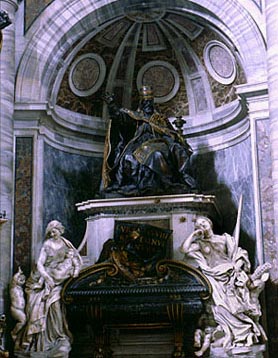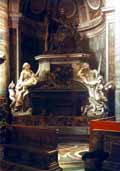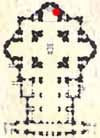 |
| Grottoes
Vatican City Colonnade Saints Floorplan #2 |
| Altars
Monuments The History |
|
Related Sites
|

|
The great patron of Bernini, whose Barberini Bees can be seen throughout St. Peter's, Urban VIII was also the pope that forced Galileo to recant.
|

|
 |
From: 'St. Peter's
Basilica - A Virtual Tour' by Our
Sunday Visitor
This monument to Pope Urban VIII by Bernini is a pyramidal layout similar
to the tomb of Pope Paul III though more harmonious. A tall, white marble
pedestal supports the bronze figure of the Pope giving a blessing. The
figure on the left with the children is Charity, Justice is on the right
with the sword and scale. Bernini used a skeleton to represent death for
the first time on this monument. The skeleton has written the name of
the deceased on an unfolded scroll. The bees of the Barberini family coat
of arms is displayed here while individual bees have been placed on the
monument. These bees can bee seen throughout St. Peter's Basilica.
From:
'THE NEW SAINT PETER'S'
Flanking the tribune on the right is the tomb of Urban VIII (1623-1644),
the masterpiece of sepulchral art of the 1600's. This also is one of the
glories of the great Bernini, who finished it in 1647, three years after
the death of his Maeceas. Powerfully conceived and with breadth of form,
the figure of the Pope appears in a rich cope, his hand raised in blessing;
the white marble figures of Justice and Charity, sculpted with a Greek
lightness of touch, seem to be less allegorical figures than real women,
leaning with languid grace on the sarcophagus of black marble, from which
was to be sadly spoilt in the mannerism of the 18th century.
From: 'BERNINI'
Copyright © 1997 by Rudolf Whittkower
The tomb of Urban VIII was the first purely sculptural work into which
Bernini introduced colour by using different materials. Colour for him
was never a merely decorative device, but essential for illuminating the
meaning and significance of his ideas. Here decorative elements of the
sarcophagus, the figure of death, and the papal statue, i.e. the parts
directly concerned withthe deceased,are of dark partly gilded bronze.
Unlike these with their magic colour and light effects, the white marble
allegories have a distinctly this-worldly quality. By their whiteness,
too, they form a transition between the observer and the papal figure
which, by virtue of its colour alone, seems far removed from the sphere
of the beholder. Any yet this pope with the powerful gesture of benediction
commands all our attention.
From: 'Lives of
the Popes' Copyright © 1997 by Richard P. McBrien
It was under Urban VIII that Galileo Galilei (d.1642), although a personal
friend, was condemned for a second time and forced to renounce the Copernican
system under threat of torture (1633).
Urban VIII consecrated the new St. Peter's Basilica on November 18, 1626, and commissioned the famous sculptor and architect Gian Lorenzo Bernini (d.1680) and other artists to beautify the basilica and the streets and piazzas of Rome. He selected Castel Gandolfo, some fifteen miles southeast of Rome, as a summer residence.
In a bull date April 22, 1639, he prohibited slavery of any kind among Indians of Brazil, Paraguay, and the entire West Indies.

